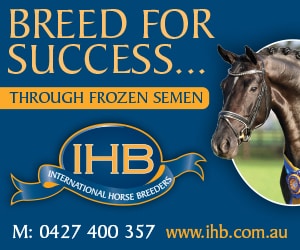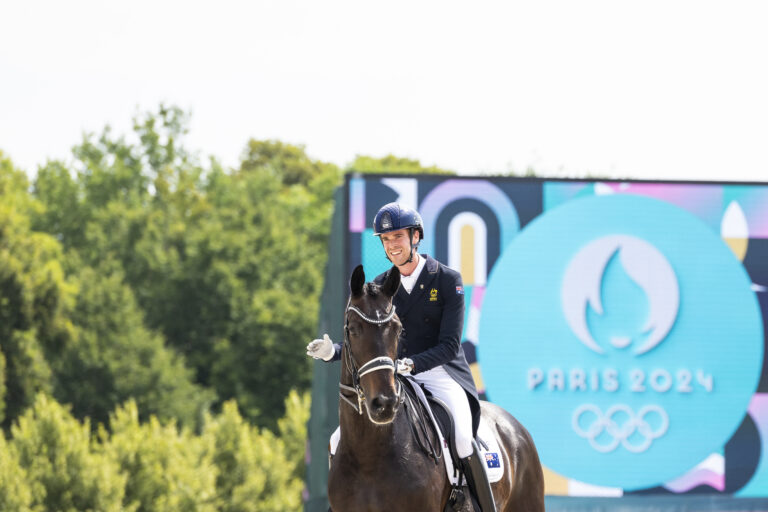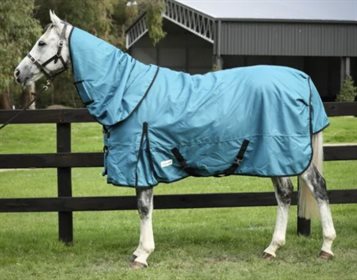This article has appeared previously with Equestrian Life. To see what is in our latest issue, please click here.

Briony Randle and off the track Thoroughbred Entourage took top honours at the 2016 Garryowen Equestrienne Turnout.
© RASV
By Equestrian Life
For many years, Thoroughbreds that have been ‘sacked’ by the racing industry for a variety of reasons are snapped up and some have gone on to successfully campaign in a number of disciplines. Not the least of these is in the show ring.
It may seem like stating the obvious to say that Thoroughbreds are a particular breed and they are bred for a very specific purpose – to race. But, working on the principle that nothing is as simple as it seems – particularly when it comes to horses – what does it take to select and retrain Thoroughbreds for a new life? Another factor on the ‘temptation to buy one’ scale comes from the fact that many a top eventer has come off the track and traditionally, some Australian riders have campaigned them at Olympics and top international events because of their speed over a cross-country course. That is starting to change. But, acquiring one for much lower competition levels requires some very careful consideration.
Greg Gerry started looking for Thoroughbreds ‘off the track’ when he was a teenager. He was typical of many keen young riders – graduating through the likes of Ponies and Galloways and then turning to the Hack ring and wondering where to find the type of championship horse that is wowing the crowd. Having always had an interest in the racing side of the industry, due to the amount of stunning flesh an equine enthusiast could ogle, Greg found himself perusing them at racetracks and talking to trainers from a young age. With a keen eye on what he wanted, he could then talk to the trainers about securing horses if and when they would be retired from the track.
With around 25 years of experience in the practical end of spotting, securing and then training and campaigning Thoroughbreds, we asked Greg about this very subjective ‘eye’ that everyone talks about. “ One of the most important factors in spotting a potentially great Hack is having a good eye,” Greg says. “This is something that can’t really be trained – you do develop a good eye through a lot of trial and error, a process that can be both heartbreaking and expensive”. Greg also has some solid advice on trying to ‘pick’ winners ‘off the track’ based on what you have seen enjoying success in the show ring.
Greg turns that on it’s head and advises that while it is important to find a horse that falls within show ring ‘type’, prospective buyers need to focus on what they instinctively like and avoid looking only at what’s successful in the ring and taking that as a marker of what will always be a winner. “The reality is what is winning may not always be what is best. Look for what appeals to you, be true to yourself. Requisite to this bringing success will be an inherent eye as previously mentioned. Also, be realistic with regard to what you can handle and what you can train,” Greg advises. It gets back to a solid understanding about what Thoroughbreds are bred for.
If we look back around 20 years, very few Hacks in the ring weren’t Thoroughbreds. Times have changed and we are still seeing a majority of Thoroughbreds, yet other breeds are also entering the larger saddle horse competitions. One of the reasons for this, in Greg’s opinion, is that racehorses themselves have changed over time. “The style of racehorse has changed. More and more they tend to be a shorter stockier type, which to me makes them less appealing as a show-horse,” he says. The second point Greg makes is that in his opinion many riders are more aware of the difficulties in training and competing Thoroughbreds, especially younger horses ‘off the track’. The third point he makes is that the introduction of ‘Hunter’ classes has meant there are more hybrid types campaigning, as they are heavier boned and more appealing to the ‘Hunter’ classes than Thoroughbreds. His forth point is that ‘circumstances surrounding shows make it less suitable for showing a quality type Thoroughbred’.
Sue Thompson and Concerto.
And, in this on-line shopping world, the demand for Thoroughbreds has seen a commensurate growth in the number of websites that feature ‘off the track’ opportunities for buyers. It is a major temptation as people see this as a less expensive and relatively easy way to step up to a larger horse. But, like any purchase there is a large ‘buyer beware’ clause that needs to attach to such a decision. Less experienced owners and riders have discovered through months, and sometimes years, of hardship that Thoroughbreds can be difficult to handle and train and have had to then sell them on. Perhaps one of the reasons why such sites have burgeoned is because approaching Thoroughbred trainers directly can be difficult. While the racing industry is keen to see such well-bred stock rehoused, trainers themselves have little time to devote to people who may want to check out their slower stock at leisure and over a period of time. Don’t be surprised if, under those circumstances – and in the parlance of the used car trade you are a ‘tyre kicker’ rather than a qualified buyer – that you don’t get an audience at all.
More experienced and sometimes professional pleasure horse trainers do have these relationships and trainers pass on horses to them willingly. Ask around and you will soon find out who is knowledgeably retraining horses ‘off the track’. Greg gives the stark warning that ‘you can’t buy the vendor’s knowledge and experience with the horse’. This brings it back to the prospective buyer being realistic regarding their knowledge of and ability to handle a ‘hot blood’. “If you have a lower ability than the vendor, then recognise the likelihood that you may not get the same level of performance out of it”, Greg advises. Greg has sometimes advised a prospective buyer against the sale of his own horses if he felt the rider couldn’t handle the horse.
Some of the key issues Greg urges prospective buyers to seriously consider are:
Housing a thoroughbred around other horses
When coming from a racing environment, thoroughbreds tend to be flighty or ‘sharp’ on the ground. Leading Thoroughbreds can also be a challenge for someone unfamiliar with the breed. They can also be less than appreciative of other horses around them as well as people. Think about your facilities and whether or not you are equipped to house a Thoroughbred.
Getting a thoroughbred to show condition
Thoroughbreds can be difficult to get to hold weight, as they expend a lot of energy as a ‘hot blood’. Working them to achieve a good ‘top-line’ can also be a challenge. There is a very real double-edged sword here. Thoroughbreds need a lot of work to build up a frame and this requires many hours of lunging and training. This means that you need to keep the weight on, in light of a lot of hours under the saddle.
Feeding a thoroughbred
Thoroughbreds can be sensitive to certain feeds and can be picky eaters. Different feeds can and will change temperament and this can add another layer to the complexity of owning and training a Thoroughbred. Unless this type of information is available when you are buying such a horse, then it could be a fraught case of trial and error to find the right formula. Nervous horses burn calories easily and this can mean it is difficult to keep weight on. They may heat up on ‘high-grain’ diets and too much grain can predispose them to muscle cramping.
Soundness
Hot-blooded horses can be easily harmed by ineffective or inexpert handling. Because they are highly strung they are vulnerable to injuries if they shy at something unexpected or outside their normal environment. If they are stressed at being transported or when faced with a new situation, this needs to be understood as it can lead to soundness issues derived through injury.

Rebecca Farrow and off the track thoroughbred Stage Presence, winners of the 2018 Garryowen Trophy.
© Royal Melbourne Show
One of Greg’s finest horses sourced ‘off the track’ is Concerto. Foaled in 1999 and raced as Count Piccolo, he was sired by Piccolo and out of Kutterbul. Greg purchased Concerto as a four year old and started campaigning him in 2005 in Queensland. Concerto was almost a readymade hack when he came out of racing. Because of an adaptable temperament and good conformation, he rapidly made the transition to successful show hack. But, 12 months of quiet, consistent work preceded his debut, as opposed to fast fixes and shortcuts which often account for the ‘cooking’ of potentially good horses. Concerto was sold to Sue Thompson at his first Royal, and she has continued to campaign him, winning in the Hack class at Barastoc Horse of the Year in 2007, among other major successes.
ABOUT THE BREED
Arab nations have been breeding horses since the Middle –Ages. They were bred for speed, strength, conformation and temperament. Hundreds of years later, Arabians have become extremely prized as a breed. ‘Hot blooded’ refers to their temperament, which has been described by many as difficult, while others prefer to refer to it as ‘passionate’. There are only two breeds that are recognised as ‘hot bloods’ – Arabians and Thoroughbreds. Arabians reached the European continent at the beginning of the 17th century and this is when the breeding of Thoroughbreds began. Crossing Arabians with English horses created the breed.

The Darley Arabian.
All Thoroughbreds can be traced back to three sires. These ‘foundation’ stallions were secured by three Englishman, with very colourful backgrounds. The first was the ‘Byerley Turk’, named after Captain Byerley who captured this stallion from the Turks at the siege of Buda. ‘Byerley Turk’s most important descendant was ‘Herod’. Foaled in 1758, ‘Herod’s success as a sire went on to assure the continuity of the ‘Byerley Turk’ line. The second foundation stallion was the Darley Arabian. Foaled in 1700 and purchased by Thomas Darley in Aleppo (Syria) in 1704, he was shipped to Yorkshire in England and bred to numerous mares. The most successful offspring were Flying Childers and Bartlet’s Childers. The Darley Arabian is the most important of the three foundation stallions in terms of his influence on the Thoroughbred breed. The third stallion was the Godolphin Arabian. Foaled in Yemen then shipped to Syria and then on to Tunis, he was gifted to the King of France. As the story goes, he was spotted by an Englishman when he was towing a water cart on the streets of Paris. The Englishman was Edward Coke, who purchased the horse and the second Earl of Godolphin subsequently acquired the horse and bred him to many distinguished mares. He sired Lath, the greatest racehorse in England after Flying Childers. It has been suggested that the blood of the Godolphin Arabian is in every stable in England and now around the world.

The Godolphin Arabian.
READ THE LATEST NEWS ARTICLES HERE








